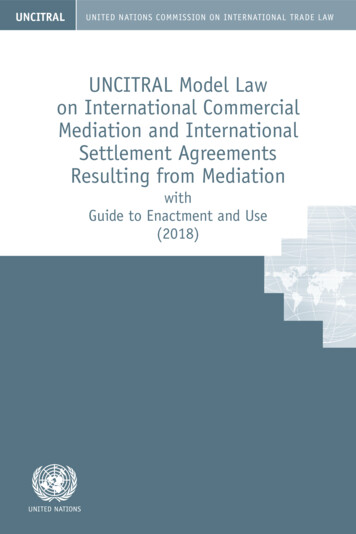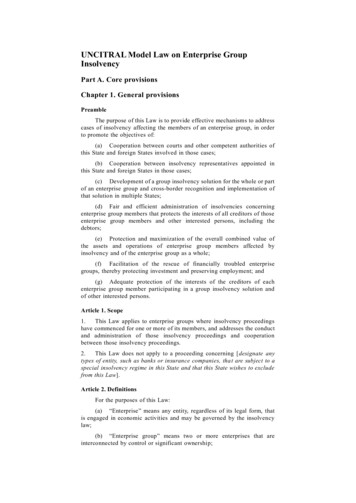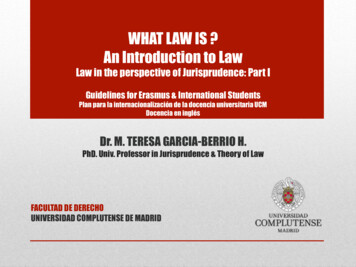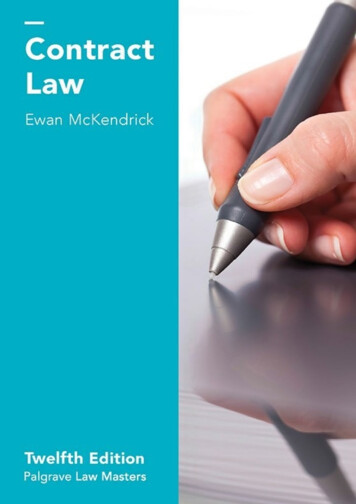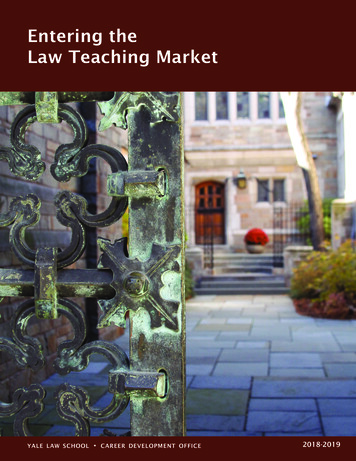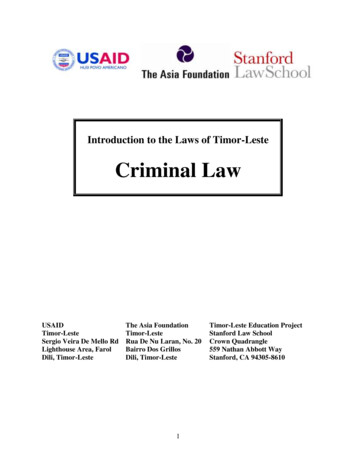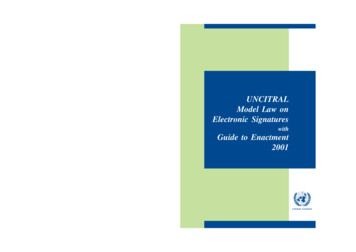
Transcription
UNCITRALModel Law onElectronic SignatureswithGuide to Enactment2001Printed in AustriaV.01-89959—April 2002—5,600United Nations publicationSales No. E.02.V.8ISBN 92-1-133653-8UNITED NATIONS
UNCITRALModel Law onElectronic SignatureswithGuide to Enactment2001UNITED NATIONSNew York, 2002
United Nations PublicationSales No. E.02.V.8ISBN 92-1-133653-8
ContentsPageResolution adopted by the General Assembly . . . . . . . . . . . . . . . . . . . . viiPart OneUNCITRAL MODEL LAW ON ELECTRONIC SIGNATURES 6.7.8.9.10.11.12.Sphere of application . . . . . . . . . . . . . . . . . . . . . . . . .Definitions . . . . . . . . . . . . . . . . . . . . . . . . . . . . . . . .Equal treatment of signature technologies . . . . . . . . . . . .Interpretation . . . . . . . . . . . . . . . . . . . . . . . . . . . . . . .Variation by agreement . . . . . . . . . . . . . . . . . . . . . . . .Compliance with a requirement for a signature . . . . . . . .Satisfaction of article 6 . . . . . . . . . . . . . . . . . . . . . . . .Conduct of the signatory . . . . . . . . . . . . . . . . . . . . . . .Conduct of the certification service provider . . . . . . . . . .Trustworthiness . . . . . . . . . . . . . . . . . . . . . . . . . . . . .Conduct of the relying party . . . . . . . . . . . . . . . . . . . .Recognition of foreign certificates and electronic signatures.112222334556Purpose of this Guide . . . . . . . . . . . . . . . . . . . . . . . . . . . . . . . . . . .7Chapter I. Introduction to the Model Law . . . . . . . . . . . . . . . . . . . . .8Part TwoGUIDE TO ENACTMENT OF THE UNCITRAL MODEL LAWON ELECTRONIC SIGNATURES (2001)I.PURPOSE AND ORIGIN OF THE MODEL LAW . . . . . . . . . . . .8A. Purpose . . . . . . . . . . . . . . . . . . . . . . . . . . . . . . . . . . . . . .8B. Background . . . . . . . . . . . . . . . . . . . . . . . . . . . . . . . . . . .9C. History . . . . . . . . . . . . . . . . . . . . . . . . . . . . . . . . . . . . . . 11II.THE MODEL LAW AS A TOOL FOR HARMONIZING LAWS . . . 18III.GENERAL REMARKS ON ELECTRONIC SIGNATURES . . . . . . . 19A. Functions of signatures . . . . . . . . . . . . . . . . . . . . . . . . . . . . 19B. Digital signatures and other electronic signatures . . . . . . . . . . . 201. Electronic signatures relying on techniques other thanpublic-key cryptography . . . . . . . . . . . . . . . . . . . . . . . . . 21iii
Page2. Digital signatures relying on public-key cryptography . . . . . 22(a) Technical notions and terminology . .(i) Cryptography . . . . . . . . . . . .(ii) Public and private keys . . . . .(iii) Hash function . . . . . . . . . . .(iv) Digital signature . . . . . . . . . .(v) Verification of digital signature.222222232424(b) Public-key infrastructure and suppliers of certificationservices . . . . . . . . . . . . . . . . . . . . . . . . . . . . . . . . 25(i) Public-key infrastructure . . . . . . . . . . . . . . . . . 26(ii) Certification service provider . . . . . . . . . . . . . . 27(c) Summary of the digital signature process . . . . . . . . . . 30IV. MAIN FEATURES OF THE MODEL LAW . . . . . . . . . . . . . . . . . 31A. Legislative nature of the Model Law . . . . . . . . . . . . . . . . . . . 31B. Relationship with the UNCITRAL Model Law on ElectronicCommerce.1. New Model Law as a separate legal instrument . . . . . . . . .2. New Model Law fully consistent with the UNCITRALModel Law on Electronic Commerce . . . . . . . . . . . . . . . .3. Relationship with article 7 of the UNCITRAL Model Law onElectronic Commerce . . . . . . . . . . . . . . . . . . . . . . . . . . .32323233C. "Framework" rules to be supplemented by technical regulationsand contract . . . . . . . . . . . . . . . . . . . . . . . . . . . . . . . . . . . 34D. Added certainty as to the legal effects of electronic signatures . . 34E. Basic rules of conduct for the parties involved . . . . . . . . . . . . 36F.A technology-neutral framework . . . . . . . . . . . . . . . . . . . . . . 38G. Non-discrimination of foreign electronic signatures . . . . . . . . . . 38V.ASSISTANCE FROM THE UNCITRAL SECRETARIAT . . . . . . . . 38A. Assistance in drafting legislation . . . . . . . . . . . . . . . . . . . . . . 38B. Information on the interpretation of legislation based on theModel Law . . . . . . . . . . . . . . . . . . . . . . . . . . . . . . . . . . . . 39Chapter II.Title . . .ArticleArticleArticleArticle-by-article remarks . . . . . . . . . . . . . . . . . . . . . . . . 39.1. Sphere of application . . . . . . . . . . . . .2. Definitions . . . . . . . . . . . . . . . . . . . .3. Equal treatment of signature technologiesiv.39404247
on . . . . . . . . . . . . . . . . . . . . . . . .Variation by agreement . . . . . . . . . . . . . . . . .Compliance with a requirement for a signature .Satisfaction of article 6 . . . . . . . . . . . . . . . . .Conduct of the signatory . . . . . . . . . . . . . . . .Conduct of the certification service provider . . .Trustworthiness . . . . . . . . . . . . . . . . . . . . . .Conduct of the relying party . . . . . . . . . . . . . .Recognition of foreign certificates and electronicsignatures . . . . . . . . . . . . . . . . . . . . . . . . . .v.4850515760636667. . . . . 69
Resolution adopted by the General Assembly[on the report of the Sixth Committee (A/56/588)]56/80 Model Law on Electronic Signaturesadopted by the United NationsCommission on InternationalTrade LawThe General Assembly,Recalling its resolution 2205 (XXI) of 17 December 1966, by which it established the United Nations Commission on International Trade Law, with a mandateto further the progressive harmonization and unification of the law of internationaltrade and in that respect to bear in mind the interests of all peoples, and particularly those of developing countries, in the extensive development of internationaltrade,Noting that an increasing number of transactions in international trade arecarried out by means of communication commonly referred to as electronic commerce, which involves the use of alternatives to paper-based forms of communication, storage and authentication of information,Recalling the recommendation on the legal value of computer records adopted by the Commission at its eighteenth session, in 1985, and paragraph 5 (b) ofGeneral Assembly resolution 40/71 of 11 December 1985, in which the Assemblycalled upon Governments and international organizations to take action, whereappropriate, in conformity with the recommendation of the Commission,1 so as toensure legal security in the context of the widest possible use of automated dataprocessing in international trade,Recalling also the Model Law on Electronic Commerce adopted by the Commission at its twenty-ninth session, in 1996,2 complemented by an additional article 5 bis adopted by the Commission at its thirty-first session, in 1998,3 andparagraph 2 of General Assembly resolution 51/162 of 16 December 1996, in whichthe Assembly recommended that all States should give favourable consideration tothe Model Law when enacting or revising their laws, in view of the need for uniformity of the law applicable to alternatives to paper-based methods of communication and storage of information,1Official Records of the Genreal Assembly, Fortieth Session, Supplement No. 17 (A/40/17),chap. VI, sect. B.2Ibid., Fifty-first Session, Supplement No. 17 (A/51/17), para. 209.3Ibid., Fifty-third Session, Supplement No. 17 (A/53/17), chap. III, B.vii
Convinced that the Model Law on Electronic Commerce is of significant assistance to States in enabling or facilitating the use of electronic commerce, as demonstrated by the enactment of that Model Law in a number of countries and itsuniversal recognition as an essential reference in the field of electronic commercelegislation,Mindful of the great utility of new technologies used for personal identification in electronic commerce and commonly referred to as electronic signatures,Desiring to build on the fundamental principles underlying article 7 of theModel Law on Electronic Commerce4 with respect to the fulfilment of the signature function in an electronic environment, with a view to promoting reliance onelectronic signatures for producing legal effect where such electronic signaturesare functionally equivalent to handwritten signatures,Convinced that legal certainty in electronic commerce will be enhanced bythe harmonization of certain rules on the legal recognition of electronic signatureson a technologically neutral basis and by the establishment of a method to assessin a technologically neutral manner the practical reliability and the commercialadequacy of electronic signature techniques,Believing that the Model Law on Electronic Signatures will constitute a useful addition to the Model Law on Electronic Commerce and significantly assistStates in enhancing their legislation governing the use of modern authenticationtechniques and in formulating such legislation where none currently exists,Being of the opinion that the establishment of model legislation to facilitatethe use of electronic signatures in a manner acceptable to States with differentlegal, social and economic systems could contribute to the development of harmonious international economic relations,1. Expresses its appreciation to the United Nations Commission onInternational Trade Law for completing and adopting the Model Law on ElectronicSignatures contained in the annex to the present resolution, and for preparing theGuide to Enactment of the Model Law;2 Recommends that all States give favourable consideration to the ModelLaw on Electronic Signatures, together with the Model Law on ElectronicCommerce adopted in 1996 and complemented in 1998, when they enact or revisetheir laws, in view of the need for uniformity of the law applicable to alternativesto paper-based forms of communication, storage and authentication of information;3 Recommends also that all efforts be made to ensure that the Model Lawon Electronic Commerce and the Model Law on Electronic Signatures, togetherwith their respective Guides to Enactment, become generally known and available.85th plenary meeting12 December 20014General Assembly resolution 51/162, annex.viii
Part OneUNCITRAL Model Law on Electronic Signatures(2001)Article 1. Sphere of applicationThis Law applies where electronic signatures are used in the context*of commercial** activities. It does not override any rule of law intendedfor the protection of consumers.Article 2. DefinitionsFor the purposes of this Law:(a) “Electronic signature” means data in electronic form in, affixedto or logically associated with, a data message, which may be used to identify the signatory in relation to the data message and to indicate the signatory’s approval of the information contained in the data message;(b) “Certificate” means a data message or other record confirming thelink between a signatory and signature creation data;(c) “Data message” means information generated, sent, received orstored by electronic, optical or similar means including, but not limited to,electronic data interchange (EDI), electronic mail, telegram, telex or telecopy;(d) “Signatory” means a person that holds signature creation data andacts either on its own behalf or on behalf of the person it represents;*The Commission suggests the following text for States that might wish to extend the applicability of this Law:"This Law applies where electronic signatures are used, except in the following situations: [.]."**The term "commercial" should be given a wide interpretation so as to cover matters arisingfrom all relationships of a commercial nature, whether contractual or not. Relationships of a commercial nature include, but are not limited to, the following transactions: any trade transaction for the supply or exchange of goods or services; distribution agreement; commercial representation or agency;factoring; leasing; construction of works; consulting; engineering; licensing; investment; financing;banking; insurance; exploitation agreement or concession; joint venture and other forms of industrialor business cooperation; carriage of goods or passengers by air, sea, rail or road.1
2UNCITRAL Model Law on Electronic Signatures with Guide to Enactment 2001(e) “Certification service provider” means a person that issues certificates and may provide other services related to electronic signatures;(f) “Relying party” means a person that may act on the basis of acertificate or an electronic signature.Article 3.Equal treatment of signature technologiesNothing in this Law, except article 5, shall be applied so as to exclude,restrict or deprive of legal effect any method of creating an electronic signature that satisfies the requirements referred to in article 6, paragraph 1,or otherwise meets the requirements of applicable law.Article 4.Interpretation1. In the interpretation of this Law, regard is to be had to its international origin and to the need to promote uniformity in its application andthe observance of good faith.2. Questions concerning matters governed by this Law which are notexpressly settled in it are to be settled in conformity with the general principles on which this Law is based.Article 5.Variation by agreementThe provisions of this Law may be derogated from or their effect maybe varied by agreement, unless that agreement would not be valid or effective under applicable law.Article 6.Compliance with a requirement for a signature1. Where the law requires a signature of a person, that requirementis met in relation to a data message if an electronic signature is used thatis as reliable as was appropriate for the purpose for which the datamessage was generated or communicated, in the light of all the circumstances, including any relevant agreement.2. Paragraph 1 applies whether the requirement referred to thereinis in the form of an obligation or whether the law simply provides consequences for the absence of a signature.3. An electronic signature is considered to be reliable for the purpose of satisfying the requirement referred to in paragraph 1 if:(a) The signature creation data are, within the context in which theyare used, linked to the signatory and to no other person;
Part One: UNCITRAL Model Law on Electronic Signatures 20013(b) The signature creation data were, at the time of signing, under thecontrol of the signatory and of no other person;(c) Any alteration to the electronic signature, made after the time ofsigning, is detectable; and(d) Where a purpose of the legal requirement for a signature is toprovide assurance as to the integrity of the information to which it relates,any alteration made to that information after the time of signing is detectable.4.Paragraph 3 does not limit the ability of any person:(a) To establish in any other way, for the purpose of satisfying therequirement referred to in paragraph 1, the reliability of an electronic signature; or(b) To adduce evidence of the non-reliability of an electronic signature.5.The provisions of this article do not apply to the following: [.].Article 7.Satisfaction of article 61. [Any person, organ or authority, whether public or private, specified by the enacting State as competent] may determine which electronicsignatures satisfy the provisions of article 6 of this Law.2. Any determination made under paragraph 1 shall be consistentwith recognized international standards.3. Nothing in this article affects the operation of the rules of privateinternational law.Article 8.Conduct of the signatory1. Where signature creation data can be used to create a signaturethat has legal effect, each signatory shall:(a) Exercise reasonable care to avoid unauthorized use of its signature creation data;(b) Without undue delay, utilize means made available by the certification service provider pursuant to article 9 of this Law, or otherwise usereasonable efforts, to notify any person that may reasonably be expectedby the signatory to rely on or to provide services in support of the electronic signature if:(i) The signatory knows that the signature creation data havebeen compromised; or
4UNCITRAL Model Law on Electronic Signatures with Guide to Enactment 2001(ii)The circumstances known to the signatory give rise to asubstantial risk that the signature creation data may havebeen compromised;(c) Where a certificate is used to support the electronic signature,exercise reasonable care to ensure the accuracy and completeness of allmaterial representations made by the signatory that are relevant to thecertificate throughout its life cycle or that are to be included in the certificate.2. A signatory shall bear the legal consequences of its failure tosatisfy the requirements of paragraph 1.Article 9.Conduct of the certification service provider1. Where a certification service provider provides services to support an electronic signature that may be used for legal effect as a signature, that certification service provider shall:(a) Act in accordance with representations made by it with respect toits policies and practices;(b) Exercise reasonable care to ensure the accuracy and completenessof all material representations made by it that are relevant to the certificatethroughout its life cycle or that are included in the certificate;(c) Provide reasonably accessible means that enable a relying partyto ascertain from the certificate:(i) The identity of the certification service provider;(ii) That the signatory that is identified in the certificate hadcontrol of the signature creation data at the time when thecertificate was issued;(iii) That signature creation data were valid at or before the timewhen the certificate was issued;(d) Provide reasonably accessible means that enable a relying partyto ascertain, where relevant, from the certificate or otherwise:(i) The method used to identify the signatory;(ii) Any limitation on the purpose or value for which the signature creation data or the certificate may be used;(iii) That the signature creation data are valid and have not beencompromised;(iv) Any limitation on the scope or extent of liability stipulatedby the certification service provider;
Part One: UNCITRAL Model Law on Electronic Signatures 20015(v) Whether means exist for the signatory to give notice pursuant to article 8, paragraph 1 (b), of this Law;(vi) Whether a timely revocation service is offered;(e) Where services under subparagraph (d) (v) are offered, provide ameans for a signatory to give notice pursuant to article 8, paragraph 1 (b),of this Law and, where services under subparagraph (d) (vi) are offered,ensure the availability of a timely revocation service;(f) Utilize trustworthy systems, procedures and human resources inperforming its services.2. A certification service provider shall bear the legal consequencesof its failure to satisfy the requirements of paragraph 1.Article 10.TrustworthinessFor the purposes of article 9, paragraph 1 (f), of this Law in determining whether, or to what extent, any systems, procedures and humanresources utilized by a certification service provider are trustworthy, regardmay be had to the following factors:(a) Financial and human resources, including existence of assets;(b) Quality of hardware and software systems;(c) Procedures for processing of certificates and applications for certificates and retention of records;(d) Availability of information to signatories identified in certificatesand to potential relying parties;(e) Regularity and extent of audit by an independent body;(f) The existence of a declaration by the State, an accreditation bodyor the certification service provider regarding compliance with or existenceof the foregoing; or(g) Any other relevant factor.Article 11.Conduct of the relying partyA relying party shall bear the legal consequences of its failure:(a) To take reasonable steps to verify the reliability of an electronicsignature; or(b) Where an electronic signature is supported by a certificate, to takereasonable steps:
6UNCITRAL Model Law on Electronic Signatures with Guide to Enactment 2001(i)To verify the validity, suspension or revocation of the certificate; and(ii) To observe any limitation with respect to the certificate.Article 12.Recognition of foreign certificatesand electronic signatures1. In determining whether, or to what extent, a certificate or an electronic signature is legally effective, no regard shall be had:(a) To the geographic location where the certificate is issued or theelectronic signature created or used; or(b) To the geographic location of the place of business of the issueror signatory.2. A certificate issued outside [the enacting State] shall have thesame legal effect in [the enacting State] as a certificate issued in [the enacting State] if it offers a substantially equivalent level of reliability.3. An electronic signature created or used outside [the enactingState] shall have the same legal effect in [the enacting State] as an electronic signature created or used in [the enacting State] if it offers a substantially equivalent level of reliability.4. In determining whether a certificate or an electronic signatureoffers a substantially equivalent level of reliability for the purposes of paragraph 2 or 3, regard shall be had to recognized international standards andto any other relevant factors.5. Where, notwithstanding paragraphs 2, 3 and 4, parties agree, asbetween themselves, to the use of certain types of electronic signatures orcertificates, that agreement shall be recognized as sufficient for the purposes of cross-border recognition, unless that agreement would not be validor effective under applicable law.
Part TwoGuide to Enactment of the UNCITRAL ModelLaw on Electronic Signatures (2001)Purpose of this Guide1. In preparing and adopting the UNCITRAL Model Law on ElectronicSignatures (also referred to in this publication as “the Model Law” or “thenew Model Law”), the United Nations Commission on International TradeLaw (UNCITRAL) was mindful that the Model Law would be a more effective tool for States modernizing their legislation if background and explanatory information were provided to executive branches of Governments andlegislators to assist them in using the Model Law. The Commission wasalso aware of the likelihood that the Model Law would be used in a number of States with limited familiarity with the type of communication techniques considered in the Model Law. This Guide, much of which is drawnfrom the travaux préparatoires of the Model Law, is also intended to behelpful to other users of the text, such as judges, arbitrators, practitionersand academics. Such information might also assist States in consideringwhich, if any, of the provisions should be varied in order to be adapted toany particular national circumstances necessitating such variation. In thepreparation of the Model Law, it was assumed that the Model Law wouldbe accompanied by such a guide. For example, it was decided in respect ofa number of issues not to settle them in the Model Law but to address themin the Guide so as to provide guidance to States enacting the Model Law.The information presented in this Guide is intended to explain why the provisions in the Model Law have been included as essential basic features ofa statutory device designed to achieve the objectives of the Model Law.2. The present Guide to Enactment has been prepared by the Secretariatpursuant to the request of UNCITRAL made at the close of its thirty-fourthsession, in 2001. It is based on the deliberations and decisions of theCommission at that session,1 when the Model Law was adopted, as well1Official Records of the General Assembly, Fifty-sixth session, Supplement No. 17 (A/56/17),paras. 201-284.7
8UNCITRAL Model Law on Electronic Signatures with Guide to Enactment 2001as on considerations of the Working Group on Electronic Commerce, whichconducted the preparatory work.Chapter I.I.Introduction to the Model LawPurpose and origin of the Model LawA.Purpose3. The increased use of electronic authentication techniques as substitutesfor handwritten signatures and other traditional authentication procedures hassuggested the need for a specific legal framework to reduce uncertainty asto the legal effect that may result from the use of such modern techniques(which may be referred to generally as “electronic signatures”). The risk thatdiverging legislative approaches be taken in various countries with respectto electronic signatures calls for uniform legislative provisions to establishthe basic rules of what is inherently an international phenomenon, wherelegal harmony as well as technical interoperability is a desirable objective.4. Building on the fundamental principles underlying article 7 of theUNCITRAL Model Law on Electronic Commerce (always referred to inthis publication under its full title to avoid confusion) with respect to thefulfilment of the signature function in an electronic environment, this newModel Law is designed to assist States in establishing a modern, harmonized and fair legislative framework to address more effectively theissues of electronic signatures. In a modest but significant addition to theUNCITRAL Model Law on Electronic Commerce, the new Model Lawoffers practical standards against which the technical reliability of electronicsignatures may be measured. In addition, the Model Law provides a linkage between such technical reliability and the legal effectiveness that maybe expected from a given electronic signature. The Model Law adds substantially to the UNCITRAL Model Law on Electronic Commerce by adopting an approach under which the legal effectiveness of a given electronicsignature technique may be predetermined (or assessed prior to beingactually used). The Model Law is thus intended to foster the understanding of electronic signatures and the confidence that certain electronic signature techniques can be relied upon in legally significant transactions.Moreover, by establishing with appropriate flexibility a set of basic rulesof conduct for the various parties that may become involved in the use ofelectronic signatures (i.e. signatories, relying parties and third-party certification service providers) the Model Law may assist in shaping more harmonious commercial practices in cyberspace.
Part Two: Guide to Enactment of the UNCITRAL Model Law on Electronic Signatures 200195. The objectives of the Model Law, which include enabling or facilitatingthe use of electronic signatures and providing equal treatment to users ofpaper-based documentation and users of computer-based information, areessential for fostering economy and efficiency in international trade. Byincorporating the procedures prescribed in the Model Law (and also the provisions of the UNCITRAL Model Law on Electronic Commerce) in itsnational legislation for those situations where parties opt to use electronicmeans of communication, an enacting State would appropriately create amedia-neutral environment. The media-neutral approach also used in theUNCITRAL Model Law on Electronic Commerce is intended to provide inprinciple for the coverage of all factual situations where information is generated, stored or communicated, irrespective of the medium on which suchinformation may be affixed (see the Guide to Enactment of the UNCITRALModel Law on Electronic Commerce, para. 24). The words “a medianeutral environment”, as used in the UNCITRAL Model Law on ElectronicCommerce, reflect the principle of non-discrimination between informationsupported by a paper medium and information communicated or stored electronically. The new Model Law equally reflects the principle that no discrimination should be made among the various techniques that may be usedto communicate or store information electronically, a principle that is oftenreferred to as “technology neutrality” (A/CN.9/484, para. 23).B.Background6. The Model Law constitutes a new step in a series of internationalinstruments adopted by UNCITRAL, which are either specifically focusedon the needs of electronic commerce or were prepared bearing in mind theneeds of modern means of communication. In the first category, specificinstruments geared to electronic commerce comprise the Legal Guide onElectronic Funds Transfers (1987), the UNCITRAL Model Law on International Credit Transfers (1992) and the UNCITRAL Model Law onElectronic Commerce (1996 and 1998). The second category consists of allinternational conventions and other legislative instruments adopted byUNCITRAL since 1978, all of which promote reduced formalism and contain definitions of “writing” that are meant to encompass dematerializedcommunications.7. The best known UNCITRAL instrument in the field of electronic commerce is the UNCITRAL Model Law on Electronic Commerce. Its preparation in the early 1990s resulted from the increased use of modern meansof communication such as electronic mail and electronic data interchange(EDI) for the conduct of international trade transactions. It was realizedthat new technologies had been developing rapidly and would develop
10UNCITRAL Model Law on Electronic Signatures with Guide to Enactment 2001further as technical supports such as information highways and the Internetbecame more widely accessible. However, the communication of legallysignificant information in the form of paperless messages was hindered bylegal obstacles to the use of such messages, or by uncertainty as to their legaleffect or validity. With a view to facilitating the increased use of modernmeans of communication, UNCITRAL
Article 6. Compliance with a requirement for a signature 1. Where the law requires a signature of a person, that requirement is met in relation to a data message if an electronic signature is used that is as reliable as was appropriate for the purpose for which the data message was generated or communicated, in the light of all the circum-
